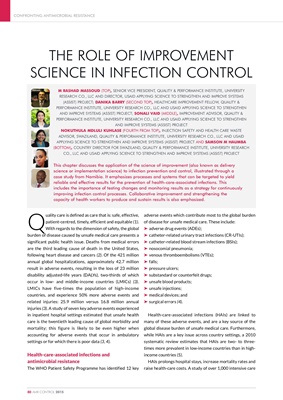
CONFRONTING ANTIMICROBIAL RESISTANCE
80 AMR CONTROL 2015
Q
uality care is defined as care that is: safe, effective,
patient-centred, timely, efficient and equitable (1).
With regards to the dimension of safety, the global
burden of disease caused by unsafe medical care presents a
significant public health issue. Deaths from medical errors
are the third leading cause of death in the United States,
following heart disease and cancers (2). Of the 421 million
annual global hospitalizations, approximately 42.7 million
result in adverse events, resulting in the loss of 23 million
disability adjusted-life years (DALYs), two-thirds of which
occur in low- and middle-income countries (LMICs) (3).
LMICs have five-times the population of high-income
countries, and experience 50% more adverse events and
related injuries: 25.9 million versus 16.8 million annual
injuries (3). A study of seven key adverse events experienced
in inpatient hospital settings estimated that unsafe health
care is the twentieth leading cause of global morbidity and
mortality; this figure is likely to be even higher when
accounting for adverse events that occur in ambulatory
settings or for which there is poor data (3, 4).
Health-care-associated infections and
antimicrobial resistance
The WHO Patient Safety Programme has identified 12 key
adverse events which contribute most to the global burden
of disease for unsafe medical care. These include:
‰ adverse drug events (ADEs);
‰ catheter-related urinary tract infections (CR-UTIs);
‰ catheter-related blood stream infections (BSIs);
‰ nosocomial pneumonia;
‰ venous thromboembolisms (VTEs);
‰ falls;
‰ pressure ulcers;
‰ substandard or counterfeit drugs;
‰ unsafe blood products;
‰ unsafe injections;
‰ medical devices; and
‰ surgical errors (4).
Health-care-associated infections (HAIs) are linked to
many of these adverse events, and are a key source of the
global disease burden of unsafe medical care. Furthermore,
while HAIs are a key issue across country settings, a 2010
systematic review estimates that HAIs are two- to threetimes
more prevalent in low-income countries than in highincome
countries (5).
HAIs prolongs hospital stays, increase mortality rates and
raise health-care costs. A study of over 1,000 intensive care
THE ROLE OF IMPROVEMENT
SCIENCE IN INFECTION CONTROL
M RASHAD MASSOUD (TOP), SENIOR VICE PRESIDENT, QUALITY & PERFORMANCE INSTITUTE, UNIVERSITY
RESEARCH CO., LLC AND DIRECTOR, USAID APPLYING SCIENCE TO STRENGTHEN AND IMPROVE SYSTEMS
(ASSIST) PROJECT; DANIKA BARRY (SECOND TOP), HEALTHCARE IMPROVEMENT FELLOW, QUALITY &
PERFORMANCE INSTITUTE, UNIVERSITY RESEARCH CO., LLC AND USAID APPLYING SCIENCE TO STRENGTHEN
AND IMPROVE SYSTEMS (ASSIST) PROJECT; SONALI VAID (MIDDLE), IMPROVEMENT ADVISOR, QUALITY &
PERFORMANCE INSTITUTE, UNIVERSITY RESEARCH CO., LLC AND USAID APPLYING SCIENCE TO STRENGTHEN
AND IMPROVE SYSTEMS (ASSIST) PROJECT
NOKUTHULA MDLULI KUHLASE (FOURTH FROM TOP), INJECTION SAFETY AND HEALTH CARE WASTE
ADVISOR, SWAZILAND, QUALITY & PERFORMANCE INSTITUTE, UNIVERSITY RESEARCH CO., LLC AND USAID
APPLYING SCIENCE TO STRENGTHEN AND IMPROVE SYSTEMS (ASSIST) PROJECT AND SAMSON M HAUMBA
(BOTTOM), COUNTRY DIRECTOR FOR SWAZILAND, QUALITY & PERFORMANCE INSTITUTE, UNIVERSITY RESEARCH
CO., LLC AND USAID APPLYING SCIENCE TO STRENGTHEN AND IMPROVE SYSTEMS (ASSIST) PROJECT
This chapter discusses the application of the science of improvement (also known as delivery
science or implementation science) to infection prevention and control, illustrated through a
case study from Namibia. It emphasizes processes and systems that can be targeted to yield
reliable and effective results for the prevention of health-care-associated infections. This
includes the importance of testing changes and monitoring results as a strategy for continuously
improving infection control processes. Collaborative improvement and strengthening the
capacity of health workers to produce and sustain results is also emphasized.